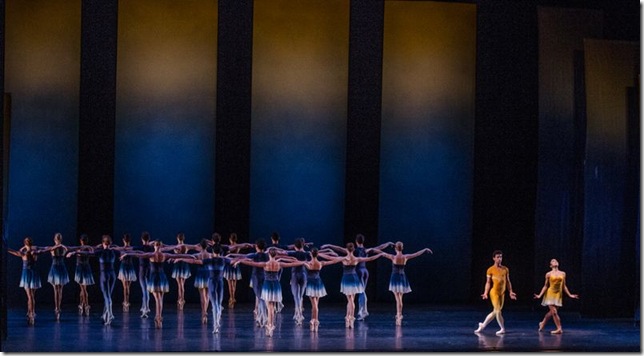The Miami City Ballet showcased its Program II, Tradition and Innovation, this weekend at the Kravis Center presenting something old and something new, but also something timeless and something different.
George Balanchine’s choreography, the mainstay of Miami City Ballet’s repertory, is known for its unsurpassed musicality, and it is interesting to note that the first two dances presented Saturday night were choreographed by Balanchine to music that the ballet master truly savored.
The first was Divertimento No. 15, set to music by Mozart. Balanchine felt that this piece was the finest divertimento Mozart ever wrote, and the dance he made is a testament to his appreciation for it. Created in 1956, the elegant and refined choreography, packed with signature speed, musical precision and refined phrasing, is a trademark piece and the company dancers performed it with ease and confidence.
The corps de ballet work was clean and strong serving as a perfect backdrop to the five women and three men soloists. Led by Jeanette Delgado performing with her usual bright presence, effortless technique and lovely, overlapping transitions, solo after solo unfolded. Standouts were Ashley Knox with her clear, precise legs and pixie Emily Bromberg with her girlish physique in her coquettish solo.
Michael Breeden possessed a wonderful lush sense of movement. Knox was also very beautiful in her pas de deux with Didier Bramaz. The shifting partnering between the five women and three men, particularly in the finale, had a touch of playfulness and a full dose of masterful craftsmanship.
The second Balanchine work on the program was Duo Concertant, choreographed to the music of Igor Stravinsky. This work, composed in 1931 for violin and piano, was Balanchine’s favorite Stravinsky piece but he waited to use it until 1972, when he finally choreographed Duo Concertant for the Stravinsky Festival.
For the entire first movement, the two dancers just stand and listen to the violinist and pianist performing onstage. It is a very Balanchine message: Dancers must listen to the music in order to put music in the steps but that can only happen after the dancer really hears the music and understands and appreciates it.
Patricia Delgado and Renan Cerdeiro drifted away from the musicians to dance only to return and listen again. They were well-matched with a marvelous sense of clarity, performing their best in the fast sections. It was wonderful to see their great attack and precise musicality responding to the complicated and difficult music of Stravinsky. The last movement of the work, suddenly performed in darkness with small spotlights, seemed disconnected and oddly over romantic after the straight forward presentation of the previous sections.
The last piece and the new work on the program was Euphotic, and it definitely showcased the company’s talent. This ambitious work was set for 28 dancers by Liam Scarlett, the 25-year-old boy wonder in the ballet world. This young choreographer is a dancer with the prestigious Royal Ballet of London and had his big break in 2010 creating his first major work for the Royal Ballet. Last year, he created Viscera for the Miami City Ballet.
Like Balanchine, Scarlett is a choreographer who relishes using the ballet vocabulary and aesthetic to create an inherent connection to the music. The sometime very dramatic score for Euphotic is the Piano Concerto No. 2 by the American composer Lowell Liebermann, whose first piano concerto served as the score for Scarlett’s Viscera.
Multi-talented as Liebermann (who debuted at Carnegie Hall at age 16 with his first Piano Sonata), dancer/choreographer Scarlett also designed the exceptionally beautiful yet minimal costumes and elegant set designs that were so integral to the visual fullness of the work. The set was composed of three vertical panels that at times looked like enormous abstract paintings, and at other times like windows with long panes of light spilling onto the stage floor and dividing the space.
Jeanette Delgado and Kleber Rebello were the excellent central couple in yellow whose locked focus was as intimate as an embrace and seemed to be a pivot in the choreography. Rippling repeating images were juxtaposed in fleeting mirroring layers as dancers seamlessly shadowed and foreshadowed each other as they exited and entered. Later, as Delgado and Rebello locked focus from afar and the dancers swirled around them, the density of the movement seemed to represent their inner emotions. Sara Esty, with her beautiful lines and clean, dynamic dancing was absolutely stunning, though later, when she was partnered by four men, the choreography seemed quite laborious.
Another highlight was the well-crafted trio with Patricia Delgado partnered by Yann Trividic and Neil Marshall that emerged from, and later dissolved into, a mystery of interchangeable couples. However, here again, the choreography of the partnering seemed laborious. Scarlett concluded Euphotic with a high-energy, full-ensemble finale.
Innovation in art, if it stands the test of time, becomes tradition, allowing room for the new to surface and ensuring the continuation and future of art as a reflection of mankind. With programs like the one Saturday night, Miami City Ballet is doing very fine work that will make sure that ballet will not just continue, but flourish.

